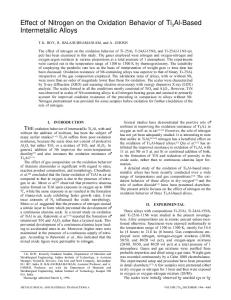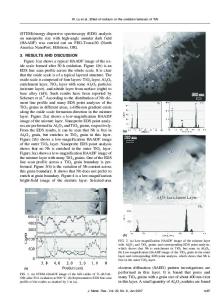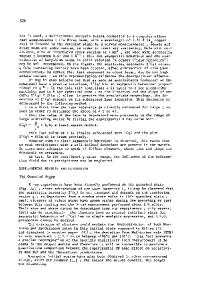Effect of Oxygen Pressure on the Initial Oxidation Behavior of Cu and Cu-Au Alloys
- PDF / 288,687 Bytes
- 6 Pages / 432 x 648 pts Page_size
- 33 Downloads / 344 Views
Effect of Oxygen Pressure on the Initial Oxidation Behavior of Cu and Cu-Au Alloys Langli Luo1, Yihong Kang2, Zhenyu Liu2, Judith C Yang2, Guangwen Zhou1 1 Department of Mechanical Engineering & Multidisciplinary Program in Materials Science and Engineering, State University of New York, Binghamton, NY 13902 2 Department of Mechanical Engineering and Materials Science, University of Pittsburgh, Pittsburgh, PA 15261 ABSTRACT A wide information gap exists between our present atomic-scale knowledge of metal oxidation derived from conventional ultrahigh vacuum (UHV) surface science experiments and the oxidation mechanisms obtained from the growth of bulk oxide thin films under technologically relevant realistic (or near-) atmospheric conditions. To bridge this pressure gap, we present an in-situ transmission electron microscopy (TEM) study of the initial oxidation stage of Cu(100) and Cu-Au(100) surfaces where the oxygen partial pressure varies from 5x10-4 to 150 Torr. For Cu(100), with increasing oxygen partial pressure (pO2), the nucleation density of the oxide islands increases and so does the growth rate of the oxide islands. As the pO2 continues to increase, a transition from epitaxial cube-on-cube Cu2O islands to randomly oriented oxide islands is observed. A kinetic model based on the classic heterogeneous nucleation theory is developed to explain the effect of oxygen partial pressure on the oxide orientation. It is shown that such a transition in the oxide nucleation orientation is related to the effect of oxygen pressure on the nucleation barrier and atom collision rate. The Cu-Au(111) alloy revealed the same oxygen pressure dependency of the oxide nucleation orientation as pure Cu oxidation. INTRODUCTION Fundamental understanding of metal and alloy oxidation is of significant importance to a wide range of applications including corrosion, catalysis, fuel reactions, electrochemistry, and thin film processing. It is well known that metal oxidation involves hierarchical multiple length scales and proceeds generally from oxygen surface chemisorptions to oxide nucleation and growth and then to the formation of a continuous, macroscopically thick oxide layer. Over the past decades, surface science studies on the oxidation of metal surfaces under idealized conditions, i.e., ultrahigh vacuum (UHV), have gathered a wealth of knowledge including the surface structure, adsorption sites, and reaction pathways. However, the resulting profound understanding of the reaction mechanism obtained under rarefied UHV conditions does not automatically translate into an equally good understanding of the technologically relevant realistic (or near-) atmospheric oxidation. For example, it has been shown recently that the surface oxidation proceed readily under high pressure oxidation conditions, but appear not to proceed under the low pressure conditions typical of a vacuum experiment, despite favorable thermodynamics[1-5]. Therefore, it is paramount to bridge this pressure gap by determining the difference in the response of a metal
Data Loading...











